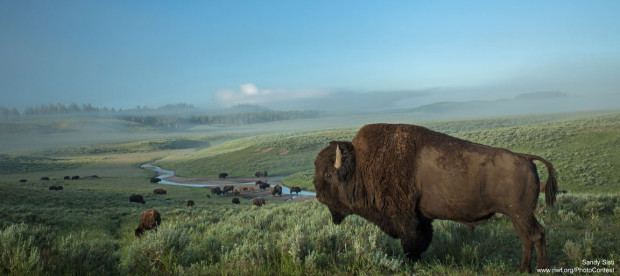We have much more to do and your continued support is needed now more than ever.
Yellowstone, Tribes Offer Bison a Better Future

Park Service officials set a goal of killing as many as 900 Yellowstone bison in just the first few months of 2016 – some through more socially acceptable traditional hunting, but the rest through capture and slaughter. Yellowstone “culls” bison under an interagency population-control agreement rooted in Montana’s unproven assertion that bison could be a threat to cattle ranching. That’s a longstanding and contentious issue.
A Better Alternative
But there’s good news: This could be the last winter that Yellowstone sends bison to slaughter en masse.
The Park Service in January rolled out a new, NWF-supported proposal for sending hundreds of bison a year to a Montana Indian reservation as an alternative to shipping them to slaughterhouses. It’s a hugely positive development that promises not only to reduce the Yellowstone slaughter, but also provide bison for restoration elsewhere.
Yellowstone bison are no ordinary wild animals. They are part of the only genetically and ecologically viable, continuously wild herd of bison in America. Numbering fewer than 5,000, Yellowstone’s bison represent the last vestige of the vast herds of bison that once roamed North America by the tens of millions.

No case of brucellosis transmission from bison to cattle has ever been documented in the wild, although several brucellosis outbreaks have been traced to elk. Nevertheless, many ranchers regard Yellowstone’s bison as a threat, and the cattle industry has used its clout to shape government policies of intolerance for bison. These policies include rounding up and slaughtering Yellowstone bison to keep the population in check.
Expanded Habitat Helps
The National Wildlife Federation has taken a pragmatic approach to the issue. NWF has negotiated agreements with the ranchers who are permitted to graze cattle on public lands adjacent to the national park to pay fair-market prices to retire those grazing allotments. NWF made deals that helped create some 400,000 acres of habitat on public lands outside the park that are virtually free of potential conflicts with cattle.

In the long term, NWF hopes to see Yellowstone’s bison-population objectives revised upward. However, pressure to reduce Yellowstone’s bison number will likely continue for years to come.
That brings us back to the recent proposal from the Park Service.
New Lease on Life Through Quarantine
Instead of shipping so many bison off to slaughterhouses, the Park Service proposes sending hundreds of captured bison a year to the Fort Peck Indian Reservation in northeastern Montana.
When captured, Yellowstone’s bison will be tested for brucellosis. Those testing negative will go to the Fort Peck Reservation. The Sioux and Assiniboine Tribes of Fort Peck have established a quarantine facility where they can hold, test and retest the bison over the several-year-long period necessary to proving and certifying the animals brucellosis-free.
The quarantine approach was proved effective at a facility adjacent to Yellowstone, and bison that emerged from that quarantine process have already become seed stock for new bison herds on the Fort Peck and Fort Belknap reservations in Montana. NWF worked in partnership with Tribes to establish those herds.
Bison for New and Expanded Herds

Yellowstone National Park played an essential role in the survival of wild bison in America. With the proposal to run bison through a tribal quarantine facility as an alternative to slaughtering animals to meet population objectives, Yellowstone could take on a significant new role in bison restoration.
Adopt a Wildlife AcreAdopt a wildlife acre now to help raise conservation funds for bison!





















